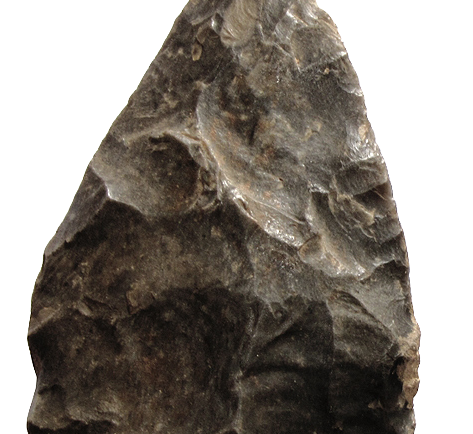Paleoanthropologist Richard Leakey began one of his last lectures by saying something funny. Still, I don’t think it was meant as a joke: “The problem that afflicted the acceptance of the position of humans and non-humans has continued to be a point at which people are uneasy and, this is when did we evolve, when did we descend, or when did we ascend from the apes? I think the answer has to be we haven’t yet. And I think it’s important to understand that—and I have often said in other opportunities to speak on the subject—that if we had not done the classification ourselves, we would not have been in a separate family from the chimpanzees!”
Dr Leakey had a respectable desire to understand the change that had occurred when our ancestors became modern humans, although he sometimes had to make quite unorthodox remarks. He said he just kept thinking about who we are and what a human is. He strove to see more profound than what his field of study created prospects for. He said that if he could choose now, he would study the latest human development, not the oldest. Sometimes, this simple goal of understanding modern human nature seems caught in the crossfire of researchers’ scientific ambitions. This is true today more than ever.
New human fossil discoveries and their dating have caused a headache among paleoanthropologists. Researchers theorise about migrations and their effect on the evolutionary patterns of modern humans. The big questions of human evolution remain open: where, when and how human development happened. All these aspects are of essential importance for understanding humans. According to researchers, man’s place of birth was in Asia, Africa or Europe. Different evolutionary models are frantically trying to prove their superiority. In the past, two evolution models were enough; today there are already five.
In addition to Recent African Origin (RAO) and the Multiregional Evolution model (MRE), there are currently three other proposals: RAO and Hybridisation model (RAOH), allowing hybridisation between the dispersing populations and the resident indigenous populations outside of Africa, and Assimilation model (AM), which denies population dispersion as the primary process, and Braided Stream model (BS), which was created to explain especially the fossil finds in the Chinese region.
The date of human emergence is also unclear. According to the current views, it has been pushed back 100,000 years, so it now seems to be 300,000 years ago. It complicates determining the place of emergence. There are also versions of how humans emerged, depending on whether one relies primarily on natural selection, genetic drift, gene flow, or all. In a recent article in Nature (590 (2021), 229–237), scholars concluded that genetic evidence and fossil records do not reveal a single point where modern humans originated. Questions are still related to all significant stages of human development: 1) human dispersal between 40,000 and 60,000 years ago, 2) African origin of modern human diversity about 60,000 to 300,000 years ago, and 3) the complex separation of modern human ancestors from archaic human groups about 300,000 to one million years ago.
Genetic evidence and fossil records don’t reveal human origins. I could buy that. They keep it secret anyhow. A psychological approach could be worth trying. In the following, I will try to untangle some confusing knots from my armchair with the help of psychology. I know it sounds weird, but we’ve seen problematic things get resolved in unorthodox ways before.
White and black sheep—a divided species of humans
I have given homo sapiens the quasi-scientific name “homo reliquiae” in this blog for a couple of reasons. First, I obviously want to question the wisdom of humans, but secondly, draw attention to the exaggerated explanatory power that paleoanthropology gives to morphology and species in evolution studies. Although morphology is essential for evolutionary researchers, overuse of it can prove dangerous and misleading. And the reason is that everything points to the genus homo always being heterogeneous regarding behaviour. Metaphorically, some black sheep were always among the white sheep in the genus homo.
This difference is significant, although it is not a colour or even visible in appearance. First, it divides the previously homogeneous human species in two. Secondly, and what is most strange, the division is behavioural and not anatomical. This complicates the case, as individuals can no longer be distinguished based on appearance. Namely, some of them start to show signs of not adapting to the expected life of a species member. Behavioural traits in the same species are not due to external characteristics but must be internal. Thus, this gives us a reason to believe that morphological aspects are not the causes but consequences of the new behavioural traits. I will dive into this topic using the parable of a flock of sheep.
Once upon a time, a species of “white sheep” existed. Then, a “black sheep” appeared in the flock one day. After that, there were always a few black sheep in the flock, but never more. For research purposes, we started calling white sheep archaic and black sheep modern to distinguish them from each other. They would live in some archaic population. Black sheep immediately created crack within the population for a couple of reasons. First, white sheep were archaic both psychologically and anatomically, but black sheep were modern only psychologically. Second, it was more difficult for the black sheep to adapt not only to the habitat of the white sheep but also to fit in with the white sheep. Black sheep stuck together. They were abnormal in a heterogeneous population. The lack of adaptation was seen immediately in their manufacturing tools. Then, indirectly and much more slowly, this feature began to influence the gradual change in the appearance of the population in the direction later known as “anatomically modern” (lighter body structure, long legs, rounded skull, small face, projecting nose, tall forehead etc.). Both archaic and modern features remained alive in the genus for over 2 million years. However, after that, only black sheep existed. The archaic features were finally lost in the evolutionary process between the first and second “sheep” migrations. This makes some call this survival and sheep’s struggle for existence.
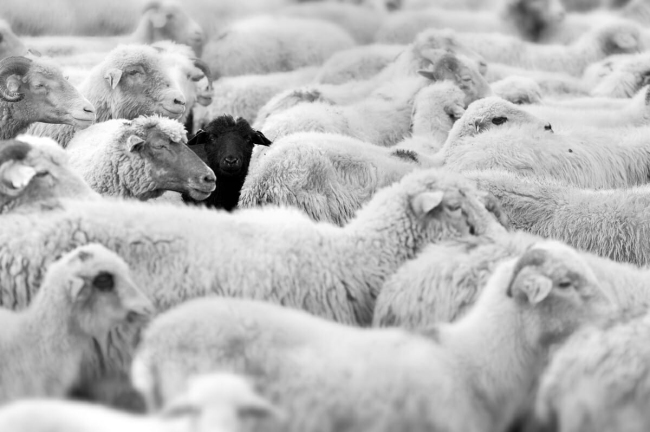
The quantitative ratio of archaic (“white sheep”) and modern (“black sheep”) humans was initially almost similar to this picture. Still, around 200–100 kya, as the population became virtually extinct, the ratio reversed and finally led to the complete disappearance of archaic humans. This had a massive impact on the culture once the population recovered. Genetically, the difference between archaic and modern is thin but behaviourally enormous. The divergence is still part of us (inhibiting our psychic growth), but it remains a mere assumption because it is inconspicuous. It, therefore, cannot serve as a research object for science. Due to that, we define “the normal” based on the wrong notions.
All the evidence suggests that about 200 kya, those with this human (black) feature, were still clearly in the minority. If we equated that to colour blindness, its number would be roughly less than 10 % of the population (and in women, even much less, which could explain many psychological differences between genders!). Because of this, a black sheep, or a single modern human feature before this point, does not represent the entire species but only its minority. Using species in defining human evolution implies protecting the imagined unity of populations, but in reality, human populations were heterogeneous also in other ways. For example, women and children certainly had a part in this play. If the modern mind, as stated above, is inherited differently in women than in men, it must affect the mutual relations between the sexes.
Moreover, if it affects mental maturity (“inhibits” it), maladjusted adults remain at the cognitive level of their children. It means that adults can teach their children much more than ever before. This is probably critical for the development of speaking and language.
Since the psychologically modern trait has emerged suddenly, the most viable explanation is that a new gene allele caused it. It could also be called a genetic defect. It appeared alongside the original allele and spread to the offspring according to its type. The new gene allele appeared regularly but so rarely that it could not fundamentally transform the species. Therefore, the allele was probably recessive (imagine colour blindness).
Nevertheless, it had an unambiguous effect on behaviour: humans could no longer adapt to their environment as before. This is the key to morphological and psychological variation in the genus homo. It’s hard to say how our genus got it, but at least it spread with the gene flow. In any case, it is at least 2–3 million years old.
The genetic defect is, first of all, seen in the fact that psychologically modern humans started making stone tools. This was utterly beyond the understanding of archaic humans. Their attitude towards life and its adversities was much more positive than modern humans. They didn’t need any tools. The manufacturing also supports the idea of a recessive gene allele. Due to recessiveness, tool-making never spread to the entire species, whether homo habilis, homo erectus or even homo neanderthalensis. Recessiveness was also reflected in the fact that tools developed very slowly, if at all, and did not have much importance for the species’ existence. The stone tools remain mostly just evidence for the heterogeneous populations.
No matter what you think, these physiological changes do not reflect human adaptation. They cannot be used as evidence for hominin evolution either. Psychologically, modern humans have been against adaptation from the beginning. They were the ultimate drivers of the change in the genus. Neither do psychological properties reflect adaptation, even if evolutionary psychologists claim otherwise. Rather, the feature refers to the so-called “cultural evolution”, if you like, even though it meant a kind of backward development, distancing from adaptation. The “cultural evolution” did not provide any noticeable advantage in normal and stable circumstances. It had only a minor effect because the trait behind it was neutral, meaning that natural selection could not affect it. Under normal circumstances, it could not spread or disappear. There was no progress in any specific direction except that the defect gradually removed the “primitive” or archaic characteristics created earlier by natural selection. It drew off them to support traits preferred by the juvenile mind of the maladapted. This happened through sexual selection. The minor physiological changes emphasised youthful features due to the same adolescent psyche. This meant gradually extending the childhood phase. The changes were neither beneficial nor detrimental to an organism’s ability to survive and reproduce. In any case, we see this development as the emergence of various human species finally leading to anatomically modern humans.
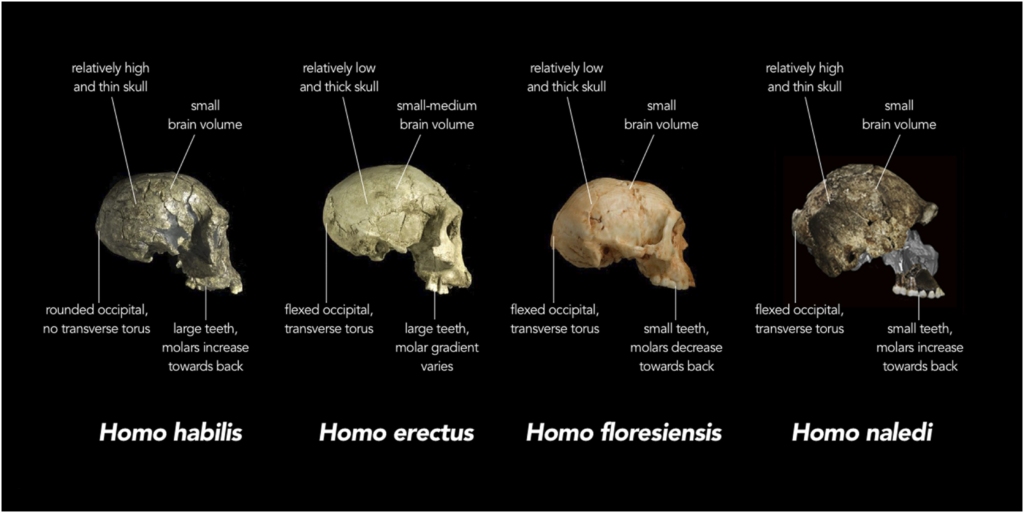
However, morphological changes do not prove development on the archaic–modern time continuum. Instead, it’s about the sexual selection of “black sheep” that begin to affect the appearance of “white sheep”. The minority sought to shape the mentality and external nature of the species. Over millions of years, the species’ childhood became more extended, and youthful features, especially facial anatomy, began to show in their appearance. The human body became more youthful (childlike even) all over. The species changed from within. It was about internal relationships, not the influence of the environment. Because of this, we cannot talk about the evolution of the species in terms of natural selection.
Even though human development is not about “anatomically modern” for a long time, the dominant feature of the first tool-making homo habilis was the same as that of later anatomically modern humans. Therefore, we can reason that an anatomically modern human should also be psychologically modern. However, this does not mean anatomically archaic humans could not be psychologically modern. They could, indeed. The “modern” is a millions-of-years-old psychological feature and may or may not appear in one or more species. Unfortunately, this differs from the prevailing view, according to which human features always are species traits. However, “modern” is not a species trait because it does not result from adaptation. Instead, it results from the opposite.
Human adaptation, speciation and evolution
Adaptations are known to be created through natural selection. This happens when animals who have more good traits are more likely to survive and, therefore, more likely to pass on their genes to the next generation. Adaptation means that one conforms to the external or internal environment conditions. Adaptation can also mean that individuals change, giving them a better chance to get along in their environment. Further, it can mean a change that reduces the psychological or physiological load on the body caused by the environment.
In mainstream science, human adaptation is a behavioural feature that has helped them better survive in their habitat. At first glance, this seems obvious and reasonable. However, on closer look, it appears human adaptation is not based on natural selection and has nothing to do with their habitat. This is strange! Humans don’t seem to have a natural habitat. Adaptation to all environments does not look like adaptation. It appears humans have not adapted their behaviour to any specific or changing habitat, but their behaviour has been an effort to ignore all habitats and living organisms. Modern humans have forced them to adapt to human needs and living conditions. In this way, humans have taken the liberty to rise above any habitat very early on. So, human survival does not mean adaptation at all. Instead, the truth can be found on the flip side, which thus must be called maladaptation. Their tools were, figuratively, not just any tools; they emerged to break the rules that nature imposed on all creation. So, modern humans play by their own rules, even though scientific definitions assume otherwise.
The archaic populations showed signs of maladaptation very early on. Maladaptation can also be seen in the first human-like skull fossils. The key is not so much the braincase as the facial features. Among the early human species, there was already a mating preference oriented towards favouring the youthful qualities of their partners. This can be deduced from the fossils that confirm their noticeable physiological rejuvenation in the facial anatomy. It can also be seen in the psyche of modern humans. We are a species that worship youth and youthful characteristics, which are especially emphasised in urban environments and the culture they produce. The driving force is the youthful trait that psychologically precedes full and mature adulthood in every growing individual. It would disappear in adulthood in archaic humans, but it remains a permanent feature in modern humans. The most prominent feature of our evolution is that modern humans have been distancing themselves from nature at an accelerating pace. It is the ultimate driver of early hominin evolution, the origin of our species, “the black sheep”. It explains the gradual change we see in the fossils of our genus and allows the research to define some species as “primitive” and others as “advanced”.

Neutral mutation of behavioural maladaptation shaped the appearance of archaic humans in the direction of modern humans over 2–3 million years somewhat restrainedly until a significant jump occurred 150–100 kya. This change did not represent “human evolution” but the accelerated anatomical “breeding” caused by sustained maladaptation and genetic drift. It was about domestication, where “black sheep”, in a sense, took a role over the reproduction of “white sheep”. This could not have happened in a homogeneous population. This later leads to the breeding of other animals and plants.—The skulls of Homo erectus, Homo heidelbergensis, a Neanderthal and a modern human. Image: Natural History Museum, UK.
This “human development” cheats us to see various primitive and advanced features in our fellow species. This view of “development” still lives on strongly as an ethical view called speciesism. Speciesism is “an ethical stance that assigns different worth or rights to beings based on their species membership, such as assigning greater rights to human beings than other animals“. So homo habilis looks more primitive to us than homo erectus, which again looks more primitive than homo neanderthalensis, which in turn looks more primitive than homo sapiens. We do not want to belong to the same species as them. Nevertheless, in the scientific scene, the development of humans from ape-like creatures into increasingly “adapted” beings is still without explanation. We should be able to tell the black sheep from the white sheep, unless otherwise, then by defining them as different species.
As mentioned, defining the early human species only in terms of human-like traits gives a false colour to their interpretation. Focusing only on stone tools and fossils showing human evolution means excluding the vast majority. Fossils and stone tools cannot describe all individuals in prehuman populations. And the human-like individuals were not exactly “all”! None was “average” or “normal” in their populations. The ratio of these two is essential since it varies and affects how quickly or slowly populations change. However reasonable it would be to assume that the entire species manufactured and used stone tools, the view is wrong. The other side is that the “normal” majority, white sheep, is still utterly invisible to us because they left no traces. As we have not seen “white sheep”, we mistakenly focus only on “black sheep”, which will mislead us into imagining the entire species evolving gradually from primitive to advanced “black sheep”. Modern behaviour is almost the opposite of archaic behaviour. Defining archaic and modern as evolutionarily successive features leads to this misunderstanding.
Out of Africa
“Black sheep” also explain both migrations and hybridisation. The dispersals were all about the “black sheep” and only them, although there were, naturally, also archaic family members. Almost as the researchers in the Nature article (590) had identified (in quotation marks), three more distinct or practical phases in human development can be found. Those are 1) the time before genetic drift (“300,000 to one million years ago”), 2) genetic drift (“African origin of modern human diversity about 60,000 to 300,000 years ago”), and 3) the time after genetic drift (“the worldwide expansion of modern humans between 40,000 and 60,000 years ago”). The map shows both migrations caused by the loss of natural selection, aka maladaptation, in the genus homo. Both migrations are essential, but for us modern humans, a critical event happens between them. Although this information is missing from the map, it has been noted!
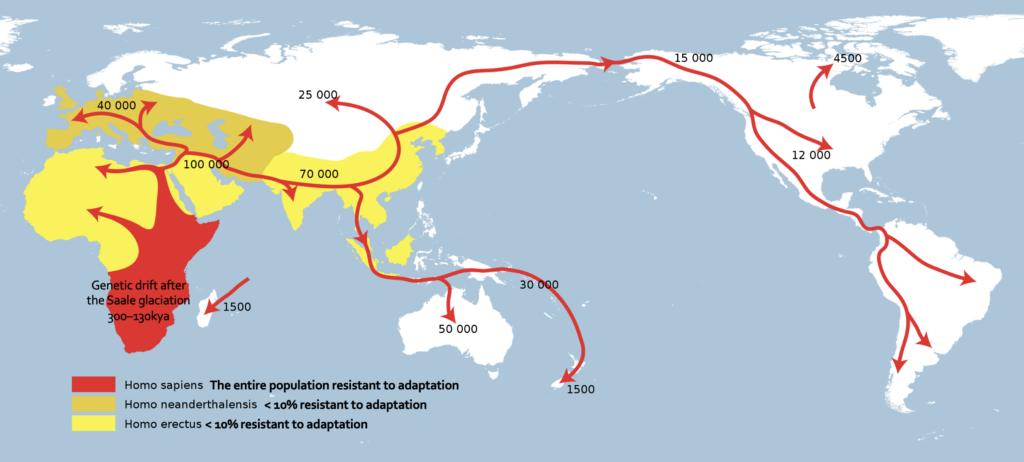
The disappearance of natural selection, or psychological maladaptation, in homo species, led to migration in two separate phases. Controversy over human origins stems from confusion surrounding the external characteristics of the human species. The morphological “development” of the human species was not the product of evolution but of breeding, and that is why it does not matter where external characteristics come from. Nor does our morphology define our skills or mental abilities. The main questions about migrations stem from the fact that paleoanthropology does not study psychological phenomena.
As explained above, the OOA-I (Out of Africa I, light and darker yellow) expansion can be seen to refer to the impact of the emergence of the genetic defect (the coverage being roughly less than 10 % of the population) on the migration of early human populations out of their habitat. So, the map’s colours do not refer to all the species in OOA-I, only maladapted individuals and their families! In genetic terms, the first migration wave still carried the original gene allele.
Interbreeding (gene flow/hybridisation) had a significant role in the morphology of homo species in Africa and elsewhere. It had more influence on the development of the early human species than modern humans. Through hybridisation, species exchanged genes and traits for over two million years. Gene flow acted to prevent speciation by maintaining similarities. The new RAOH model is also about hybridisation. However, hybridisation did not affect the evolutionary development of either migrating population. Both were already carriers of the genetic defect, so speciation had ceased as far as they were concerned, and evolutionary development no longer occurred. Therefore, the morphological changes were due to the breeding of the offspring to match the psychologically modern nature of the migrating populations.
OOA-II (red), on the other hand, was more comprehensive. It was due to the impact of the bottleneck effect, which completely changed the population composition. Under stable conditions, that could not have happened, though. Without that genetic drift, there could still be modern humans, but not a homogenous modern human species. The drift began the second phase in human evolution, the final fixation of the genetic defect and the disappearance of the original gene allele. This period is obviously missing from the map above. It dates to the end of the Saale Ice Age, about 200–100 ka years ago. The migration was preceded by a devastating drought, which replaced the original allele with its variation in a bottleneck phenomenon. Modern humans (dHs) emerge between OOA-I and OOA-II in this relatively long process. The African origin of modern human diversity about 60,000 to 300,000 years ago can be traced back to this period, although it is possible to date it even more precisely.
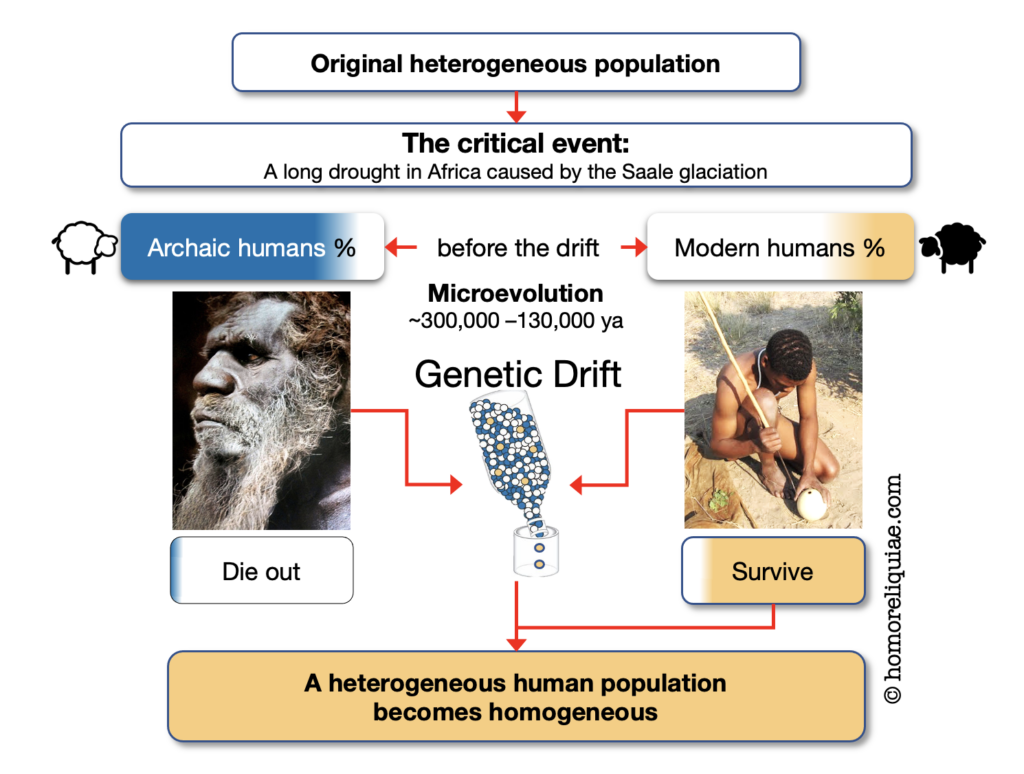
The homogenisation of one African population caused by Saale glaciation through genetic drift. Contrary to popular belief, “anatomically modern” does not define or imply any specific stage in human development. It does not mean human “completion”. The cause for cultural evolution is not anatomical but rather the fact that the human population became homogenised, i.e. the individuals carrying the original allele disappeared. In practice, archaic humans, “white sheep”, became extinct.
Genetic drift is caused by a bottleneck phenomenon that shrinks the size of the population. The size of the population is of great importance for the change of species characteristics in genetic drift. That also applies to modern humans. Scholars have confirmed that the original population leading to modern humans, shrunk a couple of times to near extinction. Small populations tend to lose genetic diversity more quickly than large populations. Additionally, a small population size means its members are likelier to breed with close relatives. The so-called drift sensitivity means rare gene alleles can disappear or multiply more easily in small populations than in large ones. It is the opposite of natural selection, requiring reasonably large populations and relatively stable conditions. Genetic drift causes the fitness and adaptability of the population to decline but does not necessarily destroy it.
The final impact of the bottleneck depends on how long it lasts and how small the population shrinks. If we want to look for the culprit, it’s the Ice age. The mighty drought in Africa caused by the Saale Ice Age (~300–130 kya) lasted for a few hundred thousand years, so it is pretty clear that the population that survived such a severe drought had no chance of returning to its former state. Regarding adaptation, the drift meant the disappearance of heterogeneity from the population. This is what the emergence of homo sapiens means. No new characteristic appeared. Only the allele that produced adaptation disappeared. Those who had nothing against adaptation were lost, and those who refused to adapt to harsh conditions survived.
For this reason, it is challenging to consider human survival from drought as an adaptation, even if we survived and then multiplied vigorously (for the same reason, we cannot talk about our fitness). On the contrary, our “development” refers to denying adaptation. Moreover, it isn’t very sure if we can even speak about human speciation because that would require adaptation to an ecological niche we do not have. We are unable to feel that we belong to nature. We call ourselves “masters of adaptation”, but there is something too bold with that. Our species survives because we force the environment to adapt to our needs, i.e. we subjugate nature to ourselves. It is more violence than adaptation. Because of this, we have ceased being part of nature’s evolution. We are at the end of our evolutionary development, a dying branch in the tree of life. Our emergence after millennia of genetic drift was an event that ended not only our evolution but also the existence of other humans.
Our common ancestor could theoretically come from any population if it makes any difference. However, virtually it could come only from where there were conditions for genetic drift. Such conditions existed in Africa after the Saale glaciation of +100 ka. The second migration wave is quite clearly the result of such an event. OOA-I, on the other hand, occurred because of the gradual spread of the defective gene allele. The origin of our species, common ancestor, or interbreeding may explain our secondary morphological characteristics but not the migrations, maladaptation, or evolution. For these reasons, I consider the original single-origin hypothesis model (RAO) slightly more accurate than the recent African origin model with hybridisation (RAOH) model.
Hybridisation cannot affect modern humans’ minds because these repel natural selection and adaptation. The human anatomical variation reflects morphological variation similar to those seen in dogs. None of the differences between dogs is directly related to their dog-like nature, just as the human morphological variation is not directly associated with our origins. Instead, it is the result of deliberate interbreeding. For this reason, the species, including modern humans, do not seem like a species but are breeds.
Hybridisation
“Archaic” and “modern” appear in paleoanthropology to describe the evolution of homo species from primitive to advanced humans. Many people are puzzled by how modern humans evolved to be able to supplant other species and remain the only human species. This is the slightly wrong way to put it because the point is not evolution. It is not for two reasons. First, the archaic and modern relationship is not an ancestor-descendant relationship. It can’t be because these traits coexisted already during the first human species (stone tools). There was no gradual development but a sudden emergence. Due to the missing ancestor-descendant relationship, there can not be an explanatory relationship regarding evolution between the human species. In other words, no other human species can explain modern humans’ exceptionality.
Second, modern human individuals are not a product of their species; on the contrary, our homo sapiens species is a product of modern human individuals. Modern humans can be said to have existed way before any modern human species. This means that the modern human species is not, strictly speaking, a product of evolution. This also means that the “genus homo” is not a genus. Instead, it is more like a species, and human species, in turn, races or breeds of the original homo stock species. Humans are as evolved as dogs compared to wolves.
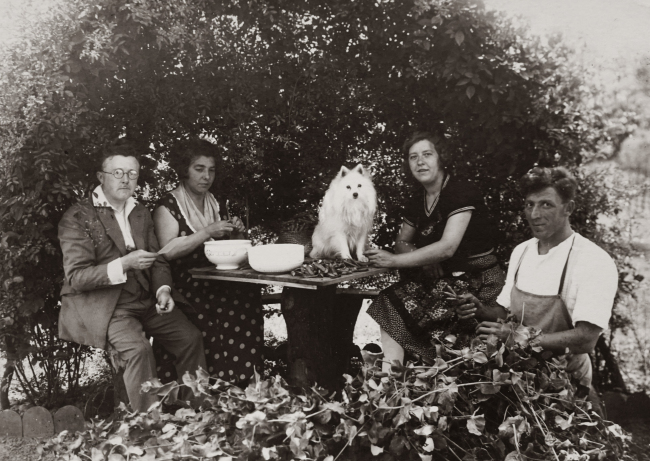
Why is a dog called a man’s best friend? Because it is a product of breeding similar to modern humans. We share a common fate. Neither is a product of natural selection. No morphological differences in dogs are directly related to their dog-like (the wolf) nature, just as the racial disparity in humans is not directly related to our origin (archaic humans). Instead, our morphology results from intentional interbreeding (sexual selection). Species arise through natural selection but race through human choice. Races describe morphological variation within species, not evolution — photo by Suzy Hazelwood.
The modern human is no more different from a homo habilis than a dog is from a wolf. All human species, except the first one, are products of breeding like dogs are and should preferably be called breeds or races. The unique feature of the genus homo has always been hostility towards evolution. It can still be seen clearly in how we hide from nature and reshape the world to be juvenile, if not childlike. So, questions related to our evolution have been wrongly posed throughout. Maybe it is the fact that we want to see the human species, especially modern humans, in a more favourable light than it is! We have always fought against evolution and chosen breeding and hybridisation instead. Therefore, the object of paleontology is the degree of interbreeding of different human populations, not evolution. No wonder human origin remains unclear. The modern human results from family lineages, not evolutionary lineages. The fact that hybridisation is increasingly central in the latest migration theories also points to races instead of species.
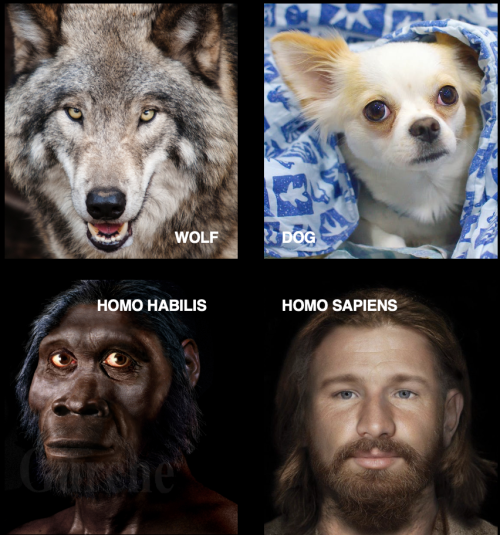
Is it possible that there are only one human species but many races, many of which are already extinct? If so, we are not “homo sapiens.”
Does science support ignorance?
We are fighting nature. Nature, our creator, has become our enemy, evil. We do not understand that we do not “come into” this world; we come out of it. We are nature, and thus, we are killing ourselves. People who pursue their interests proclaim the necessity of “development” and “progress” and lure others into a senseless and desperate struggle against nature. They say that homo sapiens are unique and have the right to think only of themselves. “Development” is a blindfold that prevents them from understanding the state of the world. They are gullible, even though they know a man cannot win. Cities and civilisations have played the meanest role in this twisted development. They have isolated people from nature physically and mentally. As a result, the rapidly increasing problems that are the price of temporary relief are brought down to nature’s shoulders.
But there is also something positive here!
We can gain an understanding of what we have lost. There is evidence for the existence of the original gene allele. It means that we know what the psyche of our ancestors was like, and therefore, we can say how it differed from that of modern humans. Even though the difference is significant, the archaic mentality is considered distortion or delusion. It can be seen in the strange way psychedelics and psychedelic research are treated. And that is also the reason why it is misunderstood or not taken seriously enough. We fear this. We do. We fear our distant past. Changes in the psyche caused by the original gene allele have been studied to some extent, but the studies still need to be completed. It can also be shown that a “weak version” of the original allele still naturally occurs. Even though the allele appears randomly and rarely, and even if it does not cause permanent changes, it affects deeply. The origin of this baffling phenomenon has been surprising for a long time but has never been connected to our evolution. It’s been called a “mystical experience” for a reason, but it has nothing to do with religion! It’s an evolutionary relic, the archaic “white sheep”! From how it appears, we can deduce that it is related to growth and especially to the functioning of the psyche. Its appearance changes the individual’s attitude towards nature and the environment into a balanced and responsive one. In this regard, it is also essential to understand the psyche of our distant ancestors.



